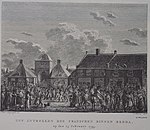Breda University of Applied Sciences
Buildings and structures in BredaEducation in North BrabantVocational universities in the Netherlands
Breda University of Applied Sciences (abbreviated as: BUas), is a Dutch vocational university in Breda, Netherlands. BUas caters for more than 7,000 Dutch and international students from over 80 countries. The institute offers professional and academic bachelor’s and master’s programmes in the domains of Games, Media, Hotel, Facility, Logistics, Built Environment, Tourism and Leisure & Events. The 5 academies at Breda University of Applied Sciences are Academy for Digital Entertainment (ADE), Academy for Leisure (AfL), Academy for Tourism (AvT), Academy of Hotel and Facility Management (HFM), Academy for Urban Development, and Logistics and Mobility (AUDLM).
Excerpt from the Wikipedia article Breda University of Applied Sciences (License: CC BY-SA 3.0, Authors).Breda University of Applied Sciences
Monseigneur Hopmansstraat, Breda
Geographical coordinates (GPS) Address Website Nearby Places Show on map
Geographical coordinates (GPS)
| Latitude | Longitude |
|---|---|
| N 51.590509 ° | E 4.795288 ° |
Address
Breda University of Applied Sciences
Monseigneur Hopmansstraat
4817 JT Breda
North Brabant, Netherlands
Open on Google Maps






